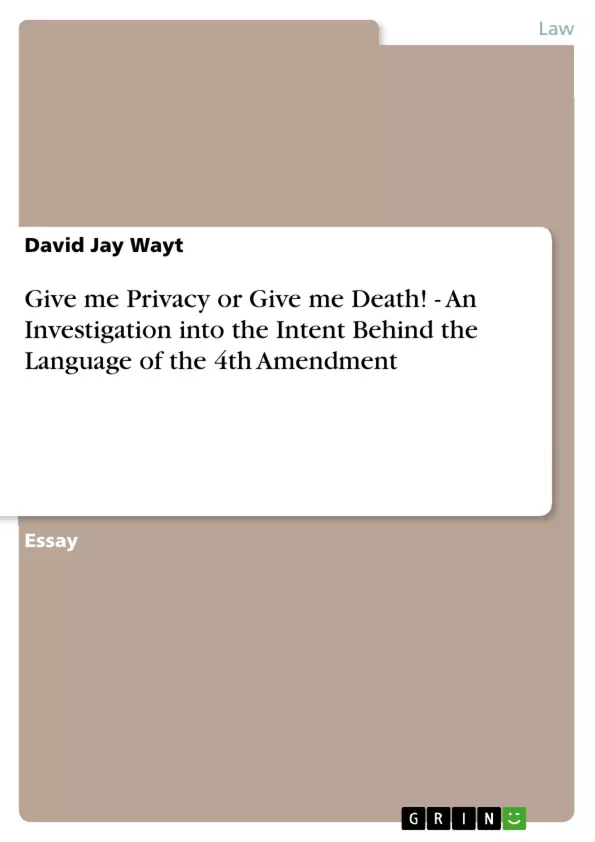Every day, people across America readily surrender both significant and
inconsequential information concerning their personal lives. That fragmented
information is available to the public and can be collected, compiled, or dispersed at
will by anybody who seeks it. By providing our private information to others, we
strip ourselves of our own privacy. With every careless disclosure, we essentially
forfeit a little more of our privacy, leaving us vulnerable to potentially invasive
Governmental surveillance. Over time, our own perspective concerning the value of
our privacy gradually diminishes, which can be reflected by subsequent judicial
decision. If we are not careful, society’s disposition in general can progressively set a
detrimental trend for potential future judicial decisions.
Just as history has demonstrated, the general attitude toward our right of
privacy might continue to evolve as time progresses. The more we surrender our
privacy, the easier it is to lose and the harder it will be to get them back once we
realize that things have gone too far.
Justice Sotomayor’s concurring opinion in U.S. v. Jones illustrates that; “GPS
monitoring generates a precise, comprehensive, record of a person’s public
movements that reflects a wealth of detailed (information) about her familial,
political, professional, religious and sexual associations.”
Potentially abusive law enforcement practices relating to certain traditional
surveillance technics were once overly burdensome, costly, and inconvenient. This
former excessively cumbersome process would ordinarily safeguard the privacy of
potential suspects but is now inexpensive and uncomplicated. From Online shopping
to surveillance cameras or GPS navigation units, we are constantly being monitored,
surveyed, and tracked. Successively emerging technological advances allow others,
including our nation’s government, to monitor our every move.
Inhaltsverzeichnis (Table of Contents)
- I. INTRODUCTION
- II. ANALYSIS
- A. The Fourth Amendment
- B. U.S. v. Jones: The Supreme Court’s Interpretations
- III. CONCLUSION
Zielsetzung und Themenschwerpunkte (Objectives and Key Themes)
This text investigates the intent behind the language of the Fourth Amendment to the United States Constitution, specifically exploring its implications in the context of modern surveillance technologies. The author examines the evolving interpretation of the Fourth Amendment, particularly in relation to the Supreme Court's rulings in cases involving GPS tracking and the concept of "reasonable expectation of privacy."
- The interpretation of the Fourth Amendment in light of technological advancements.
- The conflicting approaches to interpreting the Fourth Amendment: strict construction versus evolving interpretation.
- The concept of "reasonable expectation of privacy" and its application in surveillance cases.
- The impact of physical intrusion on the Fourth Amendment's protections.
- The potential for abuse of surveillance technologies and their impact on civil liberties.
Zusammenfassung der Kapitel (Chapter Summaries)
The Introduction discusses the increasing prevalence of information sharing and the potential for government surveillance in modern society, highlighting the diminishing value of privacy. It then introduces the concurring opinion of Justice Sotomayor in U.S. v. Jones, which emphasizes the implications of GPS monitoring on individual privacy.
The Analysis section delves into the interpretation of the Fourth Amendment. It explores the different perspectives presented by Supreme Court Justices in U.S. v. Jones, particularly regarding the language of the Fourth Amendment and the concept of "reasonable expectation of privacy." The author examines the dissenting opinion of Justice Black in Katz v. U.S., which advocates for a strict construction of the Fourth Amendment, limiting its protection to tangible items. The section also explores the majority opinion in U.S. v. Jones, which emphasizes the importance of physical intrusion, and the concurring opinion of Justice Sotomayor, who highlights the potential for abuse of surveillance technologies and the need to consider both the "trespassory intrusion" and "reasonable expectation of privacy" tests.
The Conclusion summarizes the different approaches to interpreting the Fourth Amendment, emphasizing the potential for future case law to adopt a more flexible approach to privacy protections in the face of advancing technology. It underscores the role of individual attitudes towards privacy and the importance of safeguarding personal information in the digital age.
Schlüsselwörter (Keywords)
This work centers around the Fourth Amendment, privacy, surveillance, technological advancements, reasonable expectation of privacy, physical intrusion, strict construction, evolving interpretation, U.S. v. Jones, Katz v. U.S., Justice Sotomayor, Justice Black, Justice Scalia, and Justice Alito.
- Quote paper
- David Jay Wayt (Author), 2012, Give me Privacy or Give me Death! - An Investigation into the Intent Behind the Language of the 4th Amendment, Munich, GRIN Verlag, https://www.grin.com/document/197586



